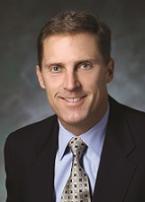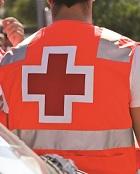
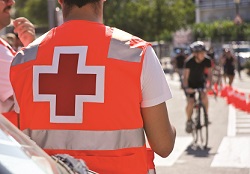
Event medical coverage should be part of overall event planning at its earliest stages. Identify and involve an event medical director (EMD), the person who will be in charge of providing medical care, in your earliest planning and preparation meetings. The EMD could be an EMT, nurse, athletic trainer, advanced practice clinician (e.g. physician assistant or nurse practitioner) or physician. Depending on the size and type of event, it is recommended that medical planning begin at least six months in advance of the event. (For major events such as the Olympics and Super Bowl, event medical planning begins years in advance).
There should be agreement between the event organizers, event director and EMD on the medical care and administrative responsibilities of the medical team. The event director will need to provide the EMD with the answers to basic medical coverage questions:
Will medical care be for participants only or participants and spectators?
Does the venue have fixed aid stations?
How many aid stations are there?
Will private or public EMS be utilized?
Will there be expense and financial support?
What special needs are anticipated (heat or cold, elderly participants, trauma in extreme sports participants)?
What has been the medical care experience at this event prior years or at similar events elsewhere?
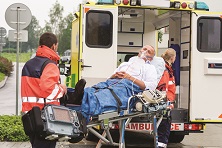 The EMD will need to be knowledgeable about the type of event, local medical resources and staffing needs, as well as the expected medical needs of the participants and spectators. The EMD should regularly attend planning meetings at which all participating and supporting agencies are represented.
The EMD will need to be knowledgeable about the type of event, local medical resources and staffing needs, as well as the expected medical needs of the participants and spectators. The EMD should regularly attend planning meetings at which all participating and supporting agencies are represented.
Don’t Re-Invent the Wheel
The EMD should reach out to and learn from others that have put on or supported a similar event. Local police and fire agencies may prove to be valuable resources. Their experiences will give the EMD a good starting point in providing medical coverage for the event. In addition, there is an abundance of credible event medical coverage planning information available on the internet. It is very likely that someone somewhere has put on a similar event and has already addressed many of the issues you will face.
Prepare for the Worst Case Scenario
Consider all the steps (identification of patient, call for help, dispatch of medical team, transportation of medical team and equipment to patient, level of on scene care, transport of patient to higher level of care, etc.) required to be able to provide timely lifesaving first aid to either a participant and/or spectator. Ensure that the medical care you provide to spectators and participants is at or above the level of medical care available to the general public.
In planning for a potential worst case scenario, your goal should be to provide advanced cardiac life support, in the form of defibrillation, to a victim of cardiac arrest within three to five minutes anywhere at your event. It is said that the safest places to experience cardiac arrest are the casinos in Las Vegas and major airports because of the training of personnel and readily available equipment (e.g. automatic external defibrillators). Whether it is a primary cardiac event or a traumatic injury, plan for a three to five-minute medical response time to any patient anywhere and practice and rehearse.
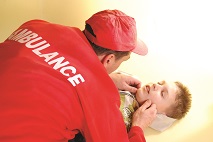 General event operational plans also impact event medical planning. Communication planning may be the most critical. All key event management personnel, including event medical personnel, should have two means of communicating. Each should have a personal cell phone and a wireless, inter-agency radio that connects venue staff, security, first aid personnel, event director, and EMD. Redundancy in communications is critical in the event that cell phone systems become overwhelmed or are nonfunctional. Other event operations elements that may impact event medical coverage include pre-event information and mailings, signage, first aid station locations, ingress and egress routes for medical vehicles, and types of vehicles to be used (e.g. bikes, ambulances, gator utility vehicles, etc.). Determine who will be responsible for making a decision to delay, postpone or cancel the event if necessary. In addition, evacuation or shelter in place plans should be in place for participants, spectators and all support staff.
General event operational plans also impact event medical planning. Communication planning may be the most critical. All key event management personnel, including event medical personnel, should have two means of communicating. Each should have a personal cell phone and a wireless, inter-agency radio that connects venue staff, security, first aid personnel, event director, and EMD. Redundancy in communications is critical in the event that cell phone systems become overwhelmed or are nonfunctional. Other event operations elements that may impact event medical coverage include pre-event information and mailings, signage, first aid station locations, ingress and egress routes for medical vehicles, and types of vehicles to be used (e.g. bikes, ambulances, gator utility vehicles, etc.). Determine who will be responsible for making a decision to delay, postpone or cancel the event if necessary. In addition, evacuation or shelter in place plans should be in place for participants, spectators and all support staff.
The medical plan should, at a minimum, contain information on the event and venue, expected participant and spectator attendance, medical personnel staffing and equipment, anticipated patient flow from venue to receiving hospitals, services offered on scene, and anticipated medical conditions and utilization. Event factors that will influence medical planning include the type of event (e.g. Little League Baseball tournament vs. extreme sports event vs. marathon), age of participants, duration of event, venue, medical assets available (fixed first aid stations, tents, cots or mobile medical support), weather, number of spectators, spectator seating and spectator use of alcohol and/or drugs. From the above information, the EMD should be able to develop a sufficient event medical plan.
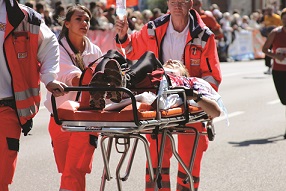
Enlisting the support of pre-hospital emergency medical service (EMS) providers is also critical. Begin your EMS planning by reaching out to the local providers. If the venue location is considered to be public and part of an EMS system’s jurisdiction, you may need to utilize public EMS providers. If, however, the venue is considered private, you may need to contract with a private ambulance service.
Develop medical care protocols that delineate onsite level of care and treatment plans, hospital transport decisions, hospital destinations for general and specialty needs (e.g. trauma, eye, pediatric, and obstetric). Work out how an ill or injured patient will “flow” from the request for care (who and how), medical provider dispatch, on scene care by event medical team, aid station, and then to hospital. Provide an orientation to all members of the medical team to ensure knowledge of and consistent implementation of the medical protocols. The EMD should develop a list of equipment and supplies needed. The number and amount of medical supplies will vary greatly on the size, duration, type of event, expected weather, as well as the level of care that your first aid team will be providing on scene.
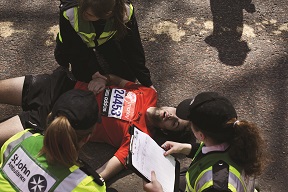
Unfortunately, sporting events with significant numbers of participants and spectators are not only high visibility events but are vulnerable and may be targeted. The medical plan for your event should be integrated into the mass casualty disaster plan for your community and include plans for ensuring the safety of your medical team. With the above information, your sporting event will have a sound, safe medical plan.

